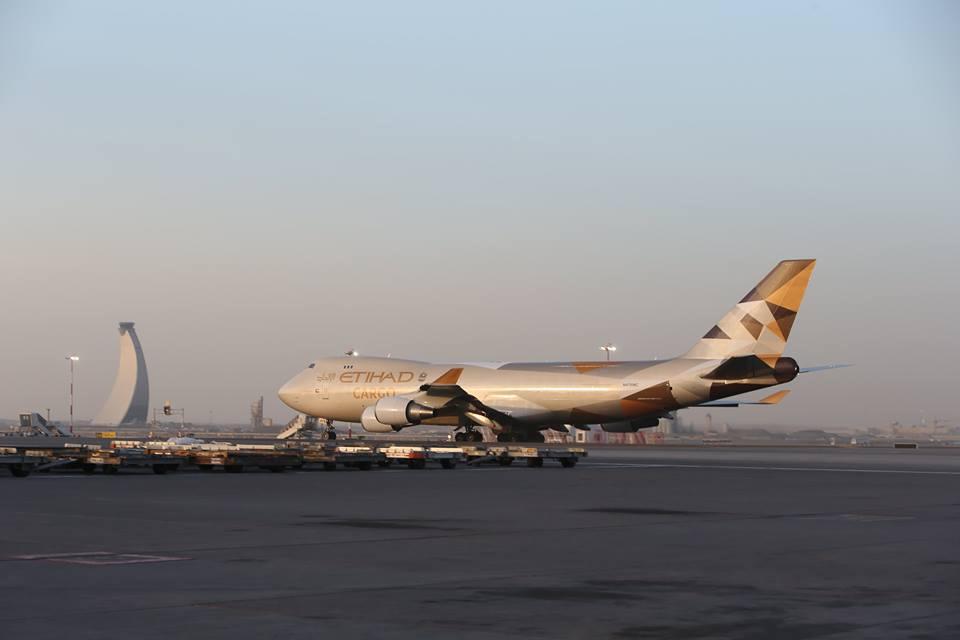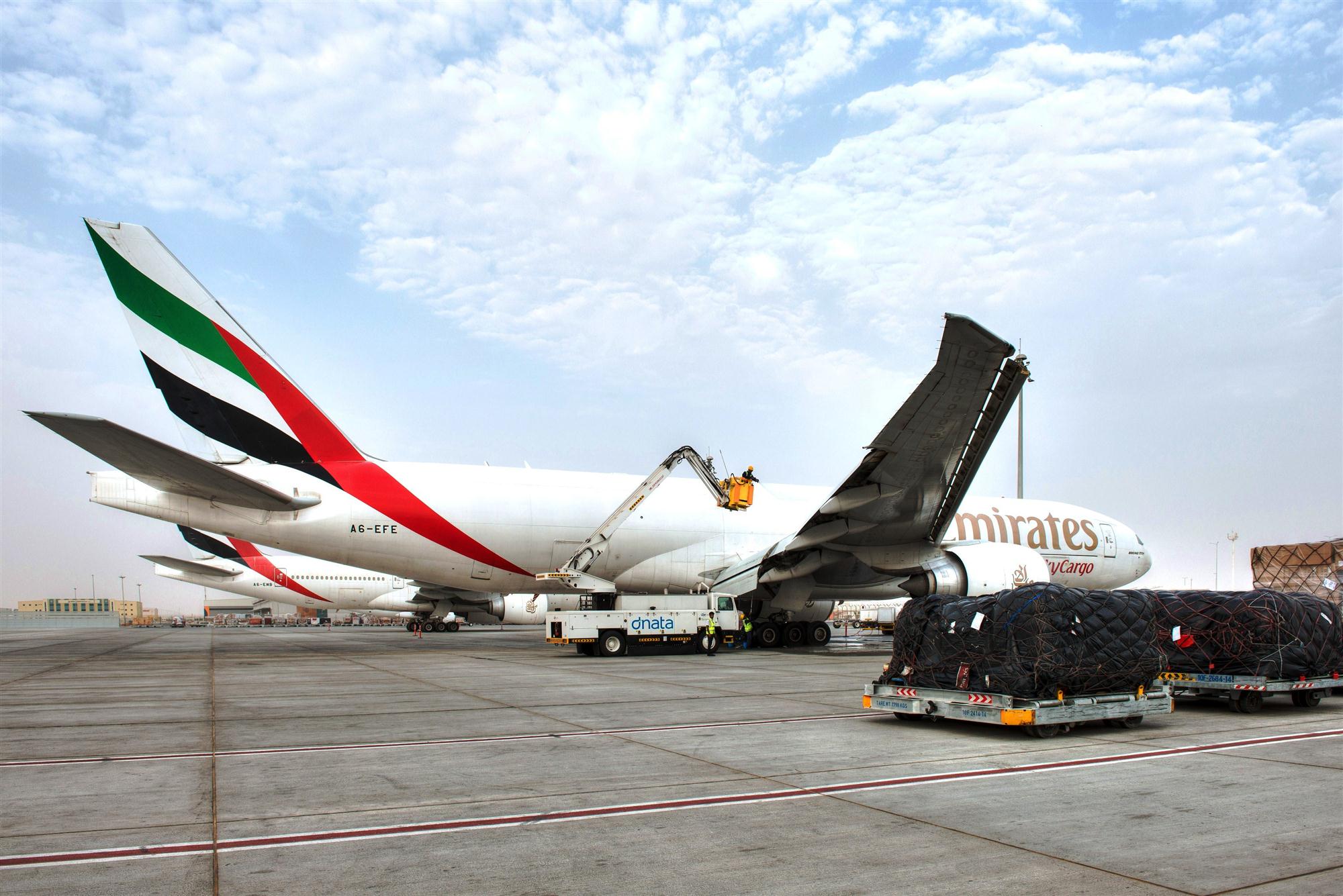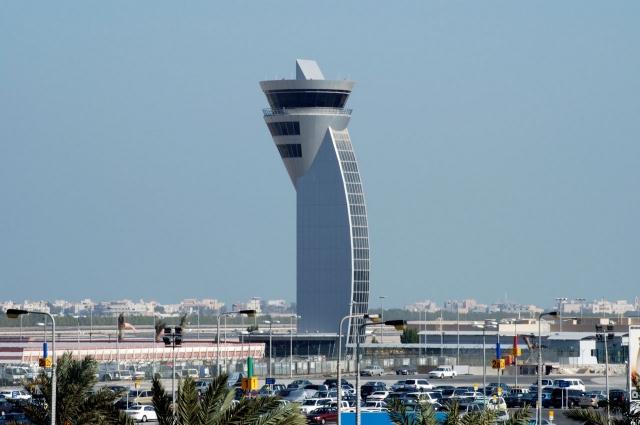Much attention has been placed on the Middle East’s various conflicts as of late, but there is another battle of a very different nature in the region’s air freight industry among a number of extremely ambitious and competitive players.
Nabil Sultan, divisional senior vice president of cargo at Emirates, says that the carrier has seen growth over the last year “across all points of sale,” with particular areas of success being Dubai, the Middle East and Africa for cargo originating from the Asia-Pacific region.
“The Middle East cargo market is buoyant, with ongoing investment and expansion by regional players supporting the continued flow of cargo volumes both into and through the key markets,” says Sultan. “In the GCC, infrastructure developments continue to drive the need for materials and supporting logistics – this is particularly noticeable in the UAE, Saudi Arabia and Qatar.
There are other reasons for the growth.
“The continued expansion and development of airport facilities across the region is also driving growth, once again particularly in the countries mentioned, as well as Oman and Jordan,” says Sultan. “Coupled with a growing consumer society with spare capital to invest, and a growing tourism industry, a range of products is being moved into the region, such as perishables, foodstuffs, pharmaceuticals, electronics, and so on.”
Emirates’ close neighbour Etihad Airways has also seen strong growth in cargo volumes over the past year, particularly to and from Asia, where it operates freighter services to key cities such as Chittagong, Guangzhou, Hanoi, Hong Kong and Kabul.
In particular, the cargo division of the Abu Dhabi-based airline carried nearly 16,000 tonnes of freight to and from Asia in 2014, which was almost a 50% over 2013, according to David Kerr, vice president of cargo at Etihad.
Saudia Cargo is another Middle Eastern carrier that has been expanding and increasing its share of the market. It now has a fleet of two Boeing 747-400Fs, two Boeing 747-400ERFs, eight Boeing 747-400 converted freighters, two Boeing 747-8Fs and two Boeing 777Fs.
“Over the last couple of years the company has been doing extremely well,” says Rainer Mueller, acting vice president of commercial at Saudia Cargo. “Since 2010, revenues have more than doubled and the fleet has almost tripled.”
One of the primary factors behind the success of the Middle East is its central geographical location, which has made it possible for the region’s airlines to successfully drive connecting traffic through their respective hubs and to open up new destinations at an impressive rate.
So far this year, Emirates has launched passenger flights to Bali, Erbil, Masshad, Multan and Orlando, as well as freighter flights to Columbus and Ouagadougou. It is also scheduled to resume flights to Baghdad and to begin passenger flights to Bamako, Bologna and Panama City.
 Saudia’s freighter network now includes Addis Ababa, Amsterdam, Brussels, Dammam, Delhi, Dhaka, Doha, Hong Kong, Houston, Jeddah, Johannesburg, Kano, Khartoum, Lagos, Milan, Mumbai, Nairobi, N’djamena, New York, Riyadh and Shanghai.
Saudia’s freighter network now includes Addis Ababa, Amsterdam, Brussels, Dammam, Delhi, Dhaka, Doha, Hong Kong, Houston, Jeddah, Johannesburg, Kano, Khartoum, Lagos, Milan, Mumbai, Nairobi, N’djamena, New York, Riyadh and Shanghai.
Compared to the other GCC countries though, Saudi Arabia has a distinct geographical advantage. “Most of our African flights start from our Jeddah hub, as Africa is only an hour’s flight time west of the city,” says Mueller.
Over the last year and a half, Qatar Airways Cargo has expanded its network, adding more than 15 freighter destinations such as Accra, Delhi, Djibouti and Guangzhou since 2014.
According to Ulrich Ogiermann, chief officer of cargo at Qatar Airways, the company’s top 10 stations for belly and freighters are Hong Kong, Frankfurt, Amsterdam, Milan, Liege, Chicago, Shanghai, Seoul, London and Paris.
Qatar Airways, which now has six Airbus A330 Freighters, a Boeing 747 Freighter and eight 777 Freighters in its fleet, carried almost 729,895 tonnes of freight on both passenger and freighter flights in 2014. The 747 freighter was recently introduced by the carrier to enhance the business offerings to its customer base. “There is a requirement in the Middle East for outsized cargo capacity and we aim to meet that demand,” says Ogiermann. “The aircraft will also supplement the existing routes as demand dictates, and also provide service integrity whenever needed.”
Ogiermann says that it has been “a year of product launches” at the airline.
The carrier launched a Pharma Express service at the beginning of the year, using an A330F to connect the pharmaceutical centres of Brussels and Basel with Doha.
In July, the airline introduced its own courier service for the door-to-door delivery of time-critical express shipments. Ogiermann says that this was aimed at the transportation of spare parts, samples, prototypes and important documents in the automotive, energy, fashion, financial, medical and pharmaceutical industries.
Etihad has launched a variety of new products and solutions that cater to the needs of its customers too. It recently launched TempCheck, which ensures the integrity of all temperature-sensitive pharmaceutical and healthcare products during transit.
 Another example is Fast Track, a premium service which was specifically designed for rapid transfer from airport to airport. Shipments are handled with priority, with preferential access to capacity and late acceptance and early retrieval of cargo.
Another example is Fast Track, a premium service which was specifically designed for rapid transfer from airport to airport. Shipments are handled with priority, with preferential access to capacity and late acceptance and early retrieval of cargo.
“This has proved very popular for customers with large volumes of time-sensitive shipments – particularly on the busy routes between China and India, where Etihad Cargo operates a non-stop freighter service from Shanghai to the key Indian markets of Delhi, Mumbai and Chennai,” says Kerr. “With the rise of e-commerce, we’re also seeing more customers selecting our Fast Track service for transporting increasing volumes of small parcel shipments between the commercial centres of Shanghai and the United Arab Emirates.”
To cater to the needs of the large Filipino expat community working in the UAE, Etihad came up with what it calls the Kabayan Box, which enables Filipino customers to send personal belongings in 20-50kg packages to Manila on one of the airline’s two daily 777-300ER flights.
In October 2014, Etihad Cargo and Avianca Cargo signed a partnership agreement to operate a twice-weekly 747-400 Freighter flight from Milan to Bogotá and from Bogotá to Amsterdam, starting in November 2014.
“The service reinforces our commitment to Milan where we already operate a freighter-only service four times per week, linking this major Southern European gateway to our hub in Abu Dhabi,” says Kerr. “This new link enhances the flow of shipments of perishables between South America and the Middle East, and onwards to Europe.”
Apart from perishables, Etihad says there is also strong demand for raw materials, machinery parts, industrial equipment and fashion items on the flight, which offers a capacity of up to 105 tonnes and is operated by Atlas Air on behalf of Etihad.
On top of the region’s own carriers, the Middle East plays a significant part in the freighter networks of other international airlines too.
One of these is China Airlines, which has had an air freight presence in the Middle East since May 1982 and, until recently, has been using Abu Dhabi as an intermediate stop for all of its freighter flights to Europe.
“The main reason we chose Abu Dhabi as CI Cargo’s Middle East hub is that it is well located between the East and West, and allowed us to refuel and carry out maintenance, enabling CI to transport more cargo and consume less fuel,” says Paul Hsueh, general manager of the cargo marketing and planning department at China Airlines. “Moreover, the stopover in Abu Dhabi used to bring extra cargo revenue as its geographical advantage attracts freight transiting between Europe and Asia.”
However, Hsueh says that China Airlines encountered difficulties such as insufficient facilities and shortage of runway slots at Abu Dhabi.
“After carefully evaluating the market potential, airport facilities and capacity, and operational flexibility, we chose Dubai World Central to be our new hub in the Middle East starting from April 16, 2015,” says Hsueh. “Furthermore, with an aim to expand our network in the Middle East and to provide more routing options for our customers, CI is actively engaged in cooperating with a number of local carriers by setting up SPA and interline agreements.”
The exponential growth in the number of flights and destinations has meant that aircraft movements are outgrowing the available capacity. In response, the region’s airports have had to plan and execute major expansions.
 In May 2014, Emirates SkyCargo, which now has a fleet of two 747-400ERFs and 13 777Fs, relocated its operations to the new Emirates SkyCentral cargo terminal at Al Maktoum International Airport, where the construction and development was carried out in two phases.
In May 2014, Emirates SkyCargo, which now has a fleet of two 747-400ERFs and 13 777Fs, relocated its operations to the new Emirates SkyCentral cargo terminal at Al Maktoum International Airport, where the construction and development was carried out in two phases.
“The facility is now fully operational and can handle 700,000 tonnes of cargo per annum,” says Sultan. “The trucking of cargo between DWC and Dubai International Airport is running smoothly and efficiently through our deployment of more than 45 trucks, 24 hours a day and seven days a week.”
Coincidentally, in the same month, Doha’s new Hamad International Airport finally opened after months of delays, bringing with it an upgrade in both size and infrastructure, which was much needed for the cargo business.
“Qatar Airways Cargo completed the transition from a manually handled cargo environment to a fully automated terminal in May 2014,” says Ogiermann. “The 55,000m2 warehouse currently manages 1.4 million tonnes of cargo per year and can handle 5,700 shipments simultaneously.”
The cargo terminal has 11 widebody aircraft stands, and the cargo complex occupies an area of 292,000m2, with a dedicated animal station, cold room, dangerous goods area and a perishable and pharmaceuticals storage area.
“Temperature-controlled handling and storage at the HIA Cargo Terminal ensures freight is stored at the appropriate temperature,” says Ogiermann. “QR Cargo is the only carrier in the Middle East to offer temperature-controlled vehicles for ramp transfers at our hub.”
 Among the major airports in the Gulf, Bahrain International Airport has perhaps the longest history, having been in operation for over 90 years. While it does not handle as much cargo as Dubai or Doha, it has its own niche and has been the base for DHL’s Middle East operations for nearly 40 years.
Among the major airports in the Gulf, Bahrain International Airport has perhaps the longest history, having been in operation for over 90 years. While it does not handle as much cargo as Dubai or Doha, it has its own niche and has been the base for DHL’s Middle East operations for nearly 40 years.
“One key differentiator is our strategic location and our proximity to the Northern Gulf,” says a representative from Bahrain Airport Company. “With Saudi Arabia only across the bridge, 45 minutes from BIA, we’re still closer to one of the biggest economic powerhouses than any of our competition. Doha is only 20 minutes away by air whilst Kuwait, Riyadh and Dubai can be accessed with a 45-minute plane ride.”
In addition, Bahrain has the shortest travel time between its seaport, airport and logistics processing zone out of anywhere in the Gulf, and has a catchment area of 5 million people, according to the spokesperson, who adds that although cargo volumes have dipped in the last few years because of Gulf Air’s downsizing and the impact of the global economic downturn, they are on the rise again, with an anticipated 20% growth in 2015 and a further jump in 2019 with the completion of a planned new terminal.
One recent development is the launch of operations of Cargolux in March 2015, which the representative says boosted the airport’s global connectivity by opening up access to over 25 new destinations.
The airport is undergoing a modernization programme, in line with the national vision for Bahrain to further grow as a leading financial, cultural and aviation centre in the Gulf region, according to the spokesperson.
“Work on the first phase of the airport expansion is already underway with immediate enhancements being done to the existing terminal; the second phase is the construction of a new terminal building due to kick off in the first quarter of 2016,” says the representative. “This project will increase the airport’s passenger and cargo handling capacity and elevate the infrastructure, facilities and services to enhance and solidify BIA’s competitive advantage in the region as a significant aviation hub.”
Continued investment in large numbers of modern, fuel-efficient aircraft types is a common feature of the major Gulf carriers.
 Qatar Airways was the first airline customer to take delivery of the A350-900 in December 2014. It had taken delivery of its first A380 just three months prior to that.
Qatar Airways was the first airline customer to take delivery of the A350-900 in December 2014. It had taken delivery of its first A380 just three months prior to that.
“The A380 and A350 are welcome additions, complementing the existing QR fleet well. The A380 offers relatively modest cargo capacity whereas the existing 777-300ER, which offers the second-biggest passenger capacity in the QR fleet, is known for its generous cargo capacity,” says Ogiermann. “At the other end, the A350 has a much smaller seat count, comparable to the 787, but offers two thirds more cargo capacity than its Boeing counterpart. Thanks to these differences, Qatar Airways can now optimize the deployment of its widebody aircraft on each destination based on both the passenger and cargo demand.”
Qatar now flies the A350 to Frankfurt and Singapore, replacing the smaller 787. The A350 is also scheduled to fly to Munich, Dubai, Philadelphia, New York and Boston.
The influx of so many large aircraft into the market has led to an explosion in cost-efficient bellyhold capacity. This presents new challenges to companies like China Airlines.
“The continuous capacity expansion from the Gulf carriers has resulted in lower load factors and placed downward pressure on yields,” says Hsueh. “To ensure high load factors and the profitability of our flights, we keep a close eye on the market and seek strategic movement for a timely response to the demand-and-supply change.”
In any case, it seems clear that the ambitions of this particular part of the world aren’t slowing down any time soon.
“We are constantly looking for new opportunities,” says Mueller. “We’re actually looking into expanding our services to and from Asia, as well as increasing frequencies into Africa. These expansion plans will include cooperation projects with other partner airlines.”
Kerr says he isn’t too worried about any potential hurdles.
“Despite the obvious political and economic headwinds and the volatility they can bring, we see the market as an opportunity rather than a challenge to be overcome,” he says. “Our approach sits behind why we are presently delivering such strong growth within the cargo operation.”
Bahrain International Airport is very optimistic about the months and years ahead.
“Forecasts predict that cargo growth in the GCC will increase by an estimated 7% annually, and air cargo traffic in the Middle East will outperform all other regions until 2032,” says the representative. “The opportunities are endless and BIA is taking great strides to capitalize on the anticipated trends.”
By Jeffrey Lee
Asia Cargo News | Hong Kong




